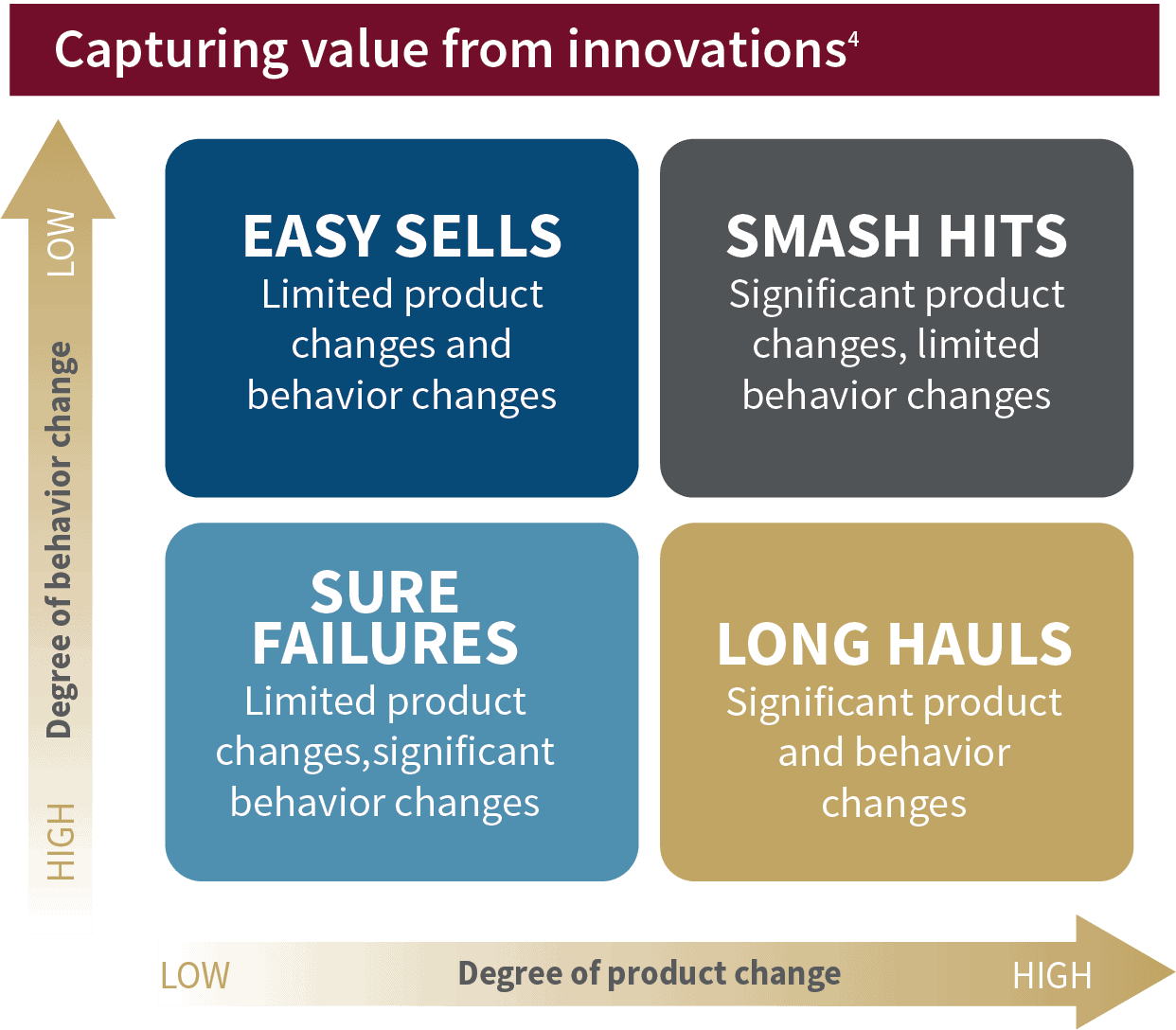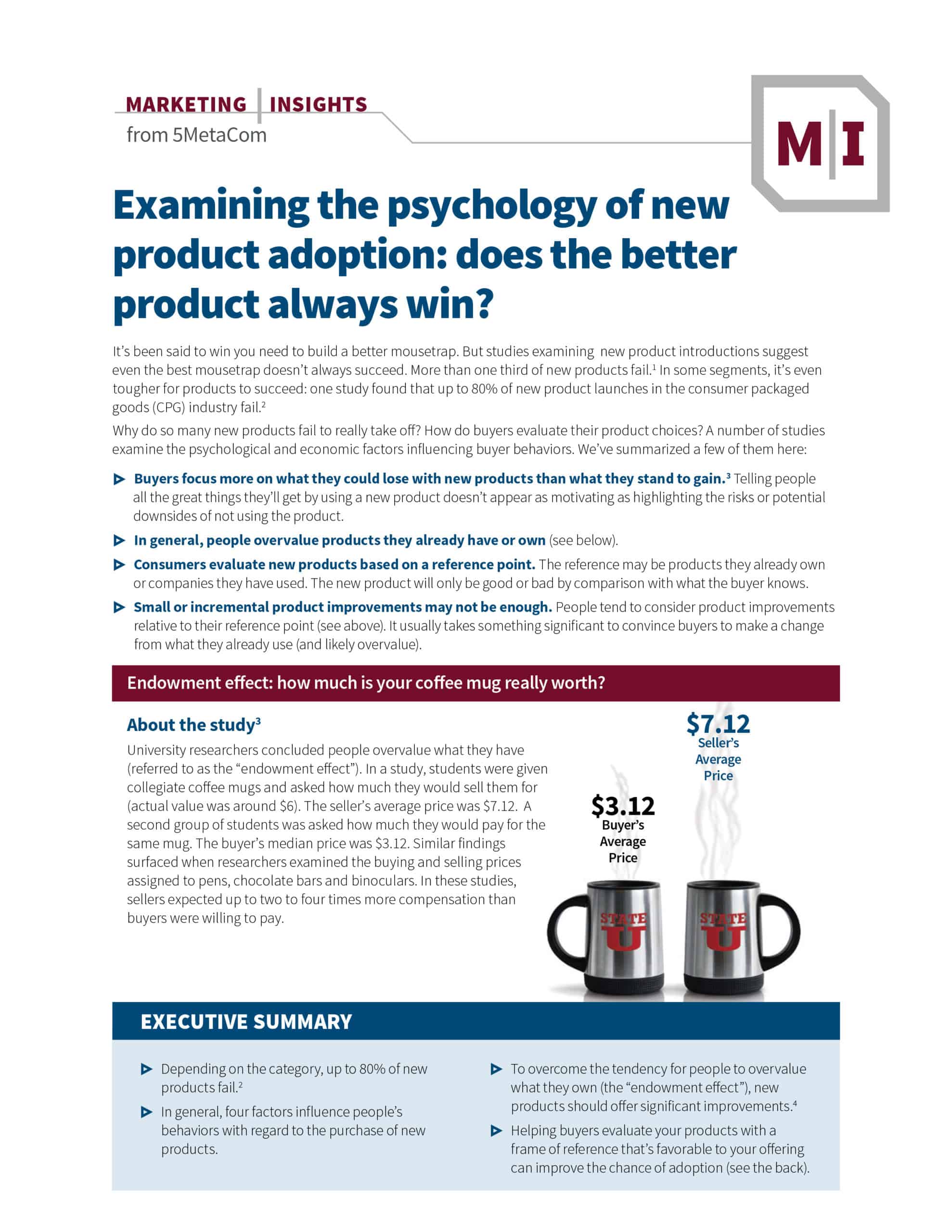Examining the psychology of new product adoption: Does the better product always win?
Why do so many new products fail to really take off? How do buyers evaluate their product choices? A number of studies examine the psychological and economic factors influencing buyer behaviors. We’ve summarized a few of them here:
- Buyers focus more on what they could lose with new products than what they stand to gain.3 Telling people all the great things they’ll get by using a new product doesn’t appear as motivating as highlighting the risks or potential downsides of not using the product.
- In general, people overvalue products they already have or own (see below).
- Consumers evaluate new products based on a reference point. The reference may be products they already own or companies they have used. The new product will only be good or bad by comparison with what the buyer knows.
- Small or incremental product improvements may not be enough. People tend to consider product improvements relative to their reference point (see above). It usually takes something significant to convince buyers to make a change from what they already use (and likely overvalue).
Endowment effect: how much is your coffee mug really worth?
About the study3
University researchers concluded people overvalue what they have (referred to as the “endowment effect”). In a study, students were given collegiate coffee mugs and asked how much they would sell them for (actual value was around $6). The seller’s average price was $7.12. A second group of students was asked how much they would pay for the same mug. The buyer’s median price was $3.12. Similar findings surfaced when researchers examined the buying and selling prices assigned to pens, chocolate bars and binoculars. In these studies, sellers expected up to two to four times more compensation than buyers were willing to pay.

EXECUTIVE SUMMARY
- Depending on the category, up to 80% of new products fail.2
- In general, four factors influence people’s behaviors with regard to the purchase of new products.
- To overcome the tendency for people to overvalue what they own (the “endowment effect”), new products should offer significant improvements.4
- Helping buyers evaluate your products with a frame of reference that’s favorable to your offering can improve the chance of adoption (se below).
Improving buyer perceptions of new product choices
With so many product launch failures, what can marketers do? Based on the psychology of new product adoption, we’ve summarized a few things that might be worth giving a try with your next product introduction.
- Tell buyers what they’ll lose by not using your products instead of what they’ll gain. Why? Research suggests buyers try to avoid losses more than capture gains.3 So they’ll likely focus more on the potential negatives of not using a new product than the positives of using it. This runs counter to the marketer’s instinct to emphasize product benefits. As an example, tell buyers how your product helps them solve a problem or avoid a pain (ideally one the competitor’s product causes).
- Minimize the amount of change needed to use your products. A behavior known as status quo bias leads consumers to feel reluctant about giving up products they already use and hesitant to trust something unfamiliar. Requiring a dramatic shift in behavior to purchase your products could lead buyers to stay with what they’ve got. Purchases that require little to no audience behavior change are more likely to succeed.
- Give buyers a framework to evaluate their choices that’s favorable to your products. Buyers tend to evaluate product choices by making comparisons to products they use or companies they work with. Helping them make that comparison in a way that’s more favorable to your offering can help speed product adoption. Because buyers tend to overvalue products they have and use, consider how to depreciate the buyer’s perception of that value as a starting point. You could point out an inconvenience or hassle the products they currently cause that they could avoid with your products. Even as you emphasize your products’ benefits, don’t forget to point out what buyers lose by not using your products.
- Show buyers what makes your products better for them (not you). Buyers overvalue the benefits of their existing products.4 At the same time, companies overvalue the benefits of their new products. If left unaddressed, this mismatch in the perception of value can hinder adoption of new products. Harvard Business Review coined this the “9x effect” to show there’s a disconnect (of 9 to 1) between what companies consider beneficial about their products and what buyers value.4 To overcome the “9x effect,” marketers should help audiences understand what’s better and different about their new products. In the realm of technical and scientific products, a relatively small improvement may be as much as you can expect (e.g., your product is 5% faster). Consider how to articulate your products’ improvements and the value offered in a way that’s motivating for buyers and not just satisfying to you.

What’s this all mean to you?
You’re probably not building mousetraps or marketing coffee mugs, but the factors influencing behaviors around the purchase of new products apply to consumer and business-to-business product categories alike. Consider how to market new products in a way that embraces the psychology of new product adoption and buyer behavior.
1 Castellion, G. and Markham, S.K. (2013, September). New Product Failure Rates. Journal of Product Innovation Management, 30(5): 976-979./
2 Catalina Personalized Digital Media. (2015). New Product Traction Through Targeted Shopper Interaction. Retrieved from https://www.cmswire.com/customer-experience/most-consumer-packaged-goods-product-launches-fail//
3 Kahneman, D., Knetsch, J. L., & Thaler, R. H. (1990). Experimental tests of the endowment effect and the Coase theorem. Journal of Political Economy, 98(6), 1325-1348./
4 Gourville, J. (2006, June). Eager Sellers and Stony Buyers: Understanding the Psychology of New-Product Adoptions. Harvard Business Review, 84(6):98-106./
